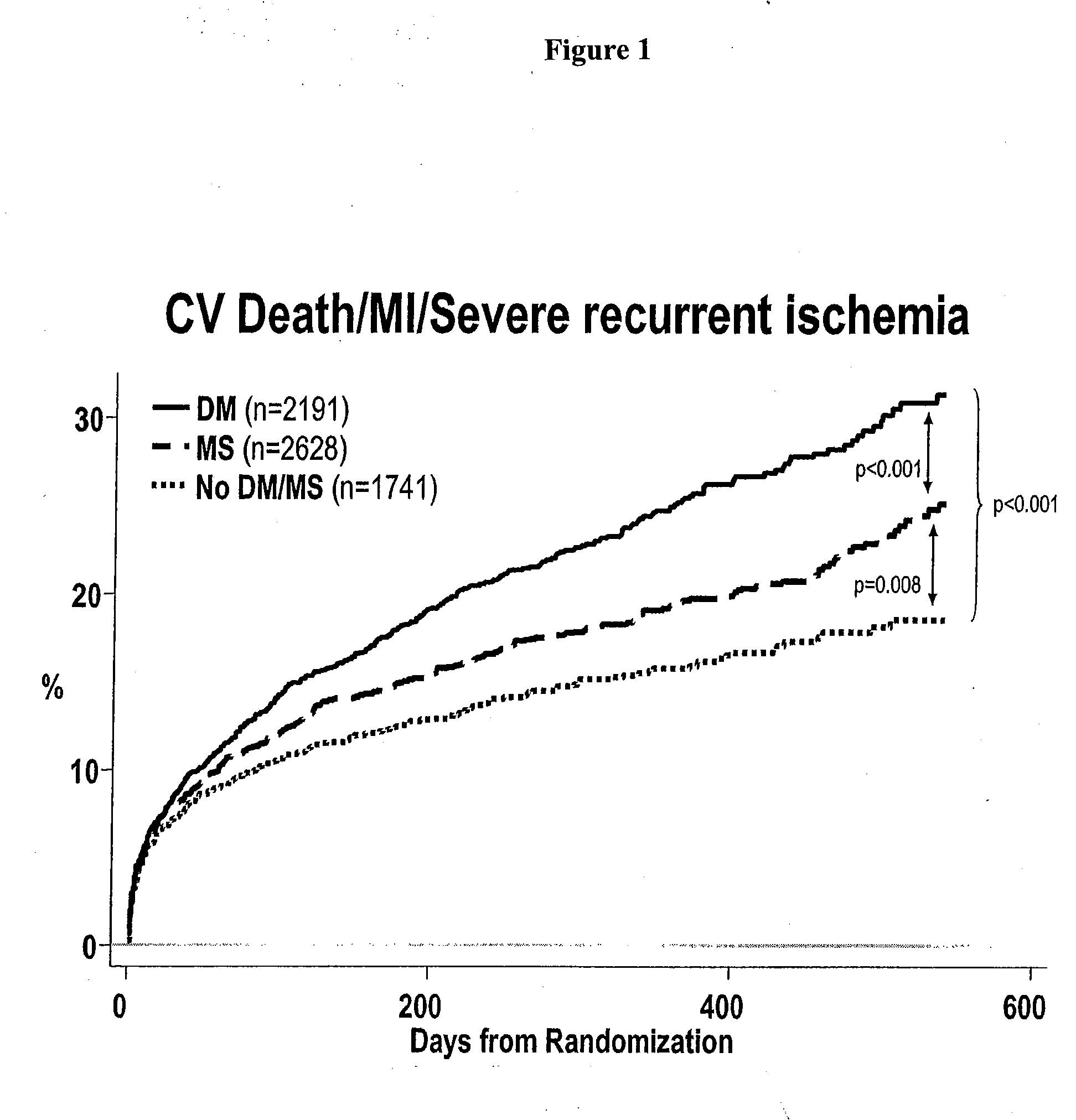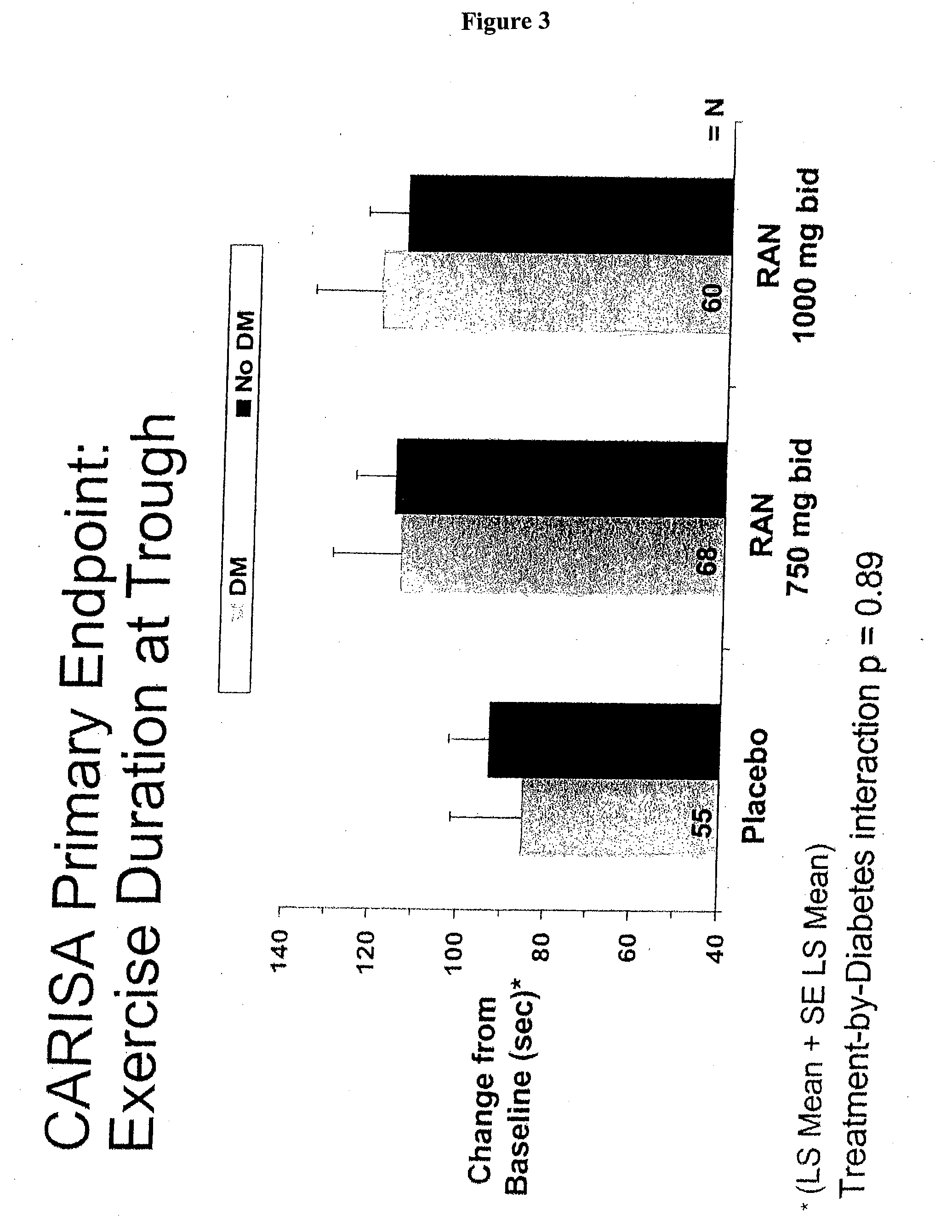Method of treating diabetes
a diabetes and treatment method technology, applied in the field of diabetes treatment, can solve the problems of increasing the risk of complications of vascular disease, increasing the public health problem of diabetes, and reducing the response of peripheral tissues to insulin, so as to reduce or slow down the development of hyperglycemia
- Summary
- Abstract
- Description
- Claims
- Application Information
AI Technical Summary
Benefits of technology
Problems solved by technology
Method used
Image
Examples
example 1
[0196] 20-mL Type 1 flint vial of Ranolazine Injection filled to deliver 20 mL (at 1, 5, or mg / mL ranolazine concentration).
[0197] Compositions:
Ranolazine1.0, 5.0, 25.0 mg / mLDextrose monohydrate55.0, 52.0, 36.0 mg / mLHydrochloric acidq.s. pH to 4.0 ± 0.2Sodium hydroxideq.s. pH to 4.0 ± 0.2Water for Injectionq.s.
[0198] Container / Closure System:
Vial:Type 1 Flint, 20-cc, 20-mm finishStopper:Rubber, 20-mm, West 4432 / 50, gray butyl, teflon coatedSeal:Aluminum, 20-mm, flip-top oversea
Method of Manufacture
[0199] The intraveous formulation of ranolazine is manufactured via an aseptic fill process as follows. In a suitable vessel, the required amount of dextrose monohydrate was dissolved in Water for Injection (WFI) at about 78% of the final batch weight. With continuous stirring, the required amount of ranolazine was added to the dextrose solution. To facilitate the dissolution of ranolazine, the solution pH was adjusted to a target of 3.88-3.92 with an 0.1 N or 1.0 N HCl solution. Ad...
example 2
[0200] 20-mL Type 1 flint vial of Ranolazine Injection are filled to deliver 20 mL (25 mg / mL concentration).
[0201] Composition:
Ranolazine25.0 mg / mLDextrose monohydrate36.0 mg / mLHydrochloric acidAdjust pH to 3.3-4.7Water for Injectionq.s.
[0202] Container / Closure System:
Vial:Type 1 tubing, untreated, 20-mL, 20-mm finishStopper:Rubber, 20-mm, West 4432 / 50, gray butylSeal:Aluminum, 20-mm, blue flip-off overseal
Method of Manufacture
[0203] Water for Injection (WFI) is charged in a suitable vessel at about 90% of the final batch weight. About 90-95% of the required amount of 5 N HCl is added into the compounding vessel. With continuous stirring, the required amount of ranolazine is slowly added, followed by the addition of dextrose monohydrate into the ranolazine solution. To solubilize ranolazine, the solution pH is adjusted with 5 N HCl solution to a target of 3.9-4.1. The batch is subsequently adjusted to the final weight with WFI. Upon confirmation that in-process specifications...
example 3
Patients with Diabetes or the Metabolic Syndrome Presenting with Non-ST-Elevation Acute Coronary Syndrome (NSTEACS)
Background
[0204] Data obtained from a clinical trial of patients admitted with non-ST elevation acute coronary syndrome (NSTEACS) was evaluated to determine the prevalence and outcome of those patients also suffering with diabetes and / or metabolic syndrome. The patients were treated with ranolazine which has been associated with improved glycemic parameters. See U.S. patent application Ser. No. 10 / 443,314, published as US 2004 / 0063717, incorporated by reference herein in its entirety.
Methods
[0205] MERLIN-TIMI 36 randomized 6560 patients at presentation with NSTEACS were treated with either placebo or the anti-ischemic agent ranolazine, which has also been associated with improved glycemic parameters. Median clinical follow-up was 12 months. Metabolic syndrome was defined as having any 3 of the following: 1) waist circumference ≧102 cm (men) and ≧88 cm (women), 2) ...
PUM
| Property | Measurement | Unit |
|---|---|---|
| Time | aaaaa | aaaaa |
| Time | aaaaa | aaaaa |
| Percent by mass | aaaaa | aaaaa |
Abstract
Description
Claims
Application Information
 Login to View More
Login to View More - R&D
- Intellectual Property
- Life Sciences
- Materials
- Tech Scout
- Unparalleled Data Quality
- Higher Quality Content
- 60% Fewer Hallucinations
Browse by: Latest US Patents, China's latest patents, Technical Efficacy Thesaurus, Application Domain, Technology Topic, Popular Technical Reports.
© 2025 PatSnap. All rights reserved.Legal|Privacy policy|Modern Slavery Act Transparency Statement|Sitemap|About US| Contact US: help@patsnap.com



